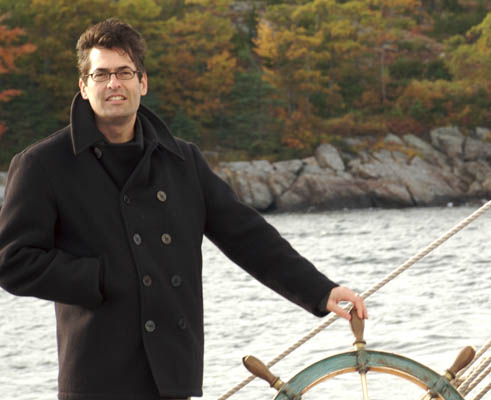Chris Jordan's concerned that we can't feel statistics. Our brains aren't hardwired to deal with high numbers. If we're going to make radical changes, we have to fall in love or feel angry enough to do something. His art translates raw data and numbers to the visual language of feeling to help people shift from self-centered consumers to compassionate, connected members of society.

Jordan takes digital images and composts them to create massive digital prints that manifest these previously inconceivable statistics. I've been admiring his images online for a while, but was fascinated by the power of his detailed prints in person. If you have the opportunity to see an exhibition, seize it. Below are a few images from his latest Running the Numbers series.
 Detail at actual size from "Jet Trails" 2007, 60" x 96" depicting 11,000 jet trails, equal to the number of commercial flights in US every eight hours. Chris took digital images of planes flying overhead, then composted them together. He originally intended to display the number of commercial flights in the US every 24 hours, but the image was completely white.
Detail at actual size from "Jet Trails" 2007, 60" x 96" depicting 11,000 jet trails, equal to the number of commercial flights in US every eight hours. Chris took digital images of planes flying overhead, then composted them together. He originally intended to display the number of commercial flights in the US every 24 hours, but the image was completely white. Sample from "Plastic Bottles" 2007, 60"x120" depicting two million plastic beverage bottles, the number used in the US every five minutes.
Sample from "Plastic Bottles" 2007, 60"x120" depicting two million plastic beverage bottles, the number used in the US every five minutes. "Cans Seurat" 2007 60" x 92" depicts 106,000 aluminum cans, the number used in the US every thirty seconds.
"Cans Seurat" 2007 60" x 92" depicts 106,000 aluminum cans, the number used in the US every thirty seconds.Other images from the series feature:
- 8 million toothpicks, which are equal to the number of trees harvested in the US every month to make the paper for mail order catalogs
- 426,000 cell phones, equal to the number of cellphones retired in the US every day
- 213,000 Vicodin pills, equal to the number of emergency room visits yearly in the US related to misuse or abuse of prescription painkillers
- 29569 handguns, equal to the number of gun-related deaths in the US in 2004
His images address deep systemic issues without simplification; there's not one person you can point to and lay blame on. In each image you can see the dramatic different ends of scale from each individual object to the massive collective. He hopes to pass on the message that the individual matters. Whether you believe you matter or don't determines your behavior. If your vote doesn't matter, why do it? If you do something bad and it doesn't matter, why not do it? On the other hand, if you realize everything you do makes a difference, you'll act consciously. And if 300 million people decide that we do matter, then the revolution happens.
Jordan pointed out that the U.S. is number one in the world in all kinds of horrendous ways and is curious why that is. If he depicted the 1.8 billion shells from handheld weapons every year with each bullet 1/12" (the size of a pinhead), the print would have to be 15 feet high by 160,000 feet wide.
He doesn't wish to be all doom and gloom however, and he quotes Van Jones, who said "Martin Luther King Jr. did not inspire a nation by saying 'I have a complaint.'" At the same time, he feels like one of the things we have to do as a culture is face up to what is, first. He offered the analogy that it's as if he woke up and realized he was an alcoholic, and that his whole family were alcoholics. "Family," he might say, "there's a whole pile of vodka in the corner. Let's look at it and talk about it."
He recommends Paul Hawken's book, Blessed Unrest: How the Largest Movement in the World Came into Being and Why No One Saw It Coming which talks about the number of organizations devoted to social justice and environmental good things — the largest mass movement in history. Paul shared his list of 130,000 organizations, and Chris plans to make a giant mandala that allows you to see all the names when you zoom in close.
In making his art, Chris notes that he began to recognize his own hypocrisy in failing to take responsibility for his own behavior and blaming his behavior on corporate entities. He realized he can make a choice to buy these plastic bottles or not. He thought it was going to be a sacrifice, but it turns out there's not a single time he's missed drinking water out of plastic bottles and been dehydrated.